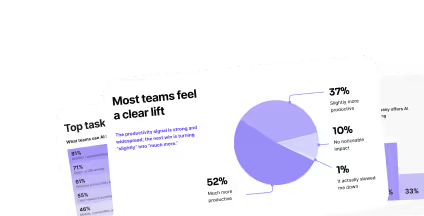Meet Steve: Director of product design at Brivo
As Director of Product Design at Brivo, I'm responsible for making work easier by helping teams plan, design, and test scalable user interactions across digital applications and hardware. Since joining Brivo in 2022, I've built a team of eight product designers who manage the entire design process from research through launch for both hardware and digital products, spanning responsive web and native mobile platforms.
Brivo stands as the global leader in cloud-based physical access control security. Our ecosystem enables businesses and organizations to monitor and control access to buildings, rooms, and facilities. We secure over 450 million square feet of space across 60 countries, with millions of users depending on our intuitive interfaces to manage critical security infrastructure.
The challenge: Standardizing design excellence
When I stepped into my role at Brivo, I immediately identified a critical gap in our design practice. While we had established internal standards, patterns, and a design system to guide our team, we lacked a standardized educational framework for continuous skill development.
Our approach to design instruction was deeply fragmented. We encouraged designers to select their own learning sources, including IxDF, Nielsen Norman Group, YouTube, LinkedIn Learning, and more. Each offered excellent materials, but this unstructured approach created several significant problems:
- No confidence that everyone understood design principles and terminology consistently
- Uncertainty about whether courses actually improved practical skills
- Excessive time requirements that busy professionals simply couldn't accommodate
- Inability to track and measure skill development across the team
In an engineering-driven company creating complex security solutions, elevating UX capabilities wasn't just about aesthetics—it was essential for product success. Our interfaces needed to be exceptionally intuitive despite the sophisticated technology underneath.
The transformation: Five superpowers unlocked with Uxcel Teams
Implementing Uxcel Teams fundamentally transformed our approach to design excellence at Brivo. The solution addressed our core challenges while unlocking capabilities we hadn't imagined possible.
1. Gamified learning for higher completion
The difference in engagement was immediately apparent. Where traditional long-form content took months to complete with disappointing completion rates, Uxcel's approach delivered quick, engaging learning experiences with 8x higher completion rates. The platform packed examples and interactions into digestible 5-minute daily sessions that fit seamlessly into our designers' workflows.
The gamification aspect created friendly competition among our team. Designers who previously viewed learning as an obligation now actively challenge each other and celebrate skill achievements.
2. Focused learning tailored to individual needs
With varied roles and seniority levels across our design team, the ability to customize learning paths proved invaluable. Uxcel allowed us to develop targeted skill development plans focused on essential topics for each role, fostering confidence and empowering growth where it mattered most.
One junior designer on our team felt overwhelmed trying to decide what to learn next before Uxcel. Now they have a clear path that builds on strengths while addressing specific skill gaps that matter for projects.
3. Data-driven team development
Uxcel's Team Skill Graph revolutionized how we visualize capabilities across our department. At a glance, I gained unprecedented visibility into each team member's unique strengths and skill gaps, revealing how they complement each other within the broader team. This visualization transformed how we assembled project teams and allocated responsibilities.
4. Enhanced personal development plans
Prior to Uxcel, we relied on manual internal skill assessments mapped out in Google Sheets—a time-consuming process with limited insight. Now, we leverage Uxcel's automated skill mapping where each skill point connects directly to relevant learning materials that impact actual project performance.
This evidence-based approach enabled us to create targeted growth plans aligned with both individual career aspirations and organizational needs. For the first time, we had quantifiable metrics showing skill progression over time.
5. Improved team dynamics through shared language
Perhaps most surprising was how Uxcel transformed our team culture. In weekly meetings, we now share learning insights from Uxcel, creating a transparent knowledge-sharing environment. This practice allows us to celebrate skill improvement while establishing a common design vocabulary that strengthens our collaboration.
We've seen direct improvements in our design system patterns. When everyone speaks the same design language and understands core principles consistently, our patterns become more cohesive and implementation becomes more efficient.
Strategic insights for design leaders
Based on our experience transforming Brivo's design practice with Uxcel Teams, I offer two key recommendations for fellow design leaders:
- Create targeted growth plans backed by objective data. Leverage skill visualization tools to identify both individual and team-level improvement opportunities. This evidence-based approach builds trust with leadership while providing designers with clear development paths.
- Foster a learning addiction, not just a learning culture. The gamified, microlearning approach generates intrinsic motivation that traditional training cannot match. When learning becomes enjoyable rather than obligatory, skill development accelerates dramatically.
The broader transformation: UX as a strategic function
The most significant outcome has been the elevation of UX within Brivo's organizational structure. What began as an effort to standardize design education has evolved into a fundamental shift in how we approach innovation.
Today, UX considerations influence product strategy from inception rather than being applied as polish near launch. Cross-functional teams proactively seek design input, recognizing its impact on user adoption and satisfaction. Executive leadership now views our design capabilities as a competitive advantage in the security technology marketplace.
By implementing Uxcel Teams, we've transformed not just our design team's capabilities, but our entire organization's approach to creating value through exceptional user experiences. In a complex technology space where ease of use directly impacts security outcomes, this transformation delivers tangible benefits for both our business and the millions who rely on our solutions daily.




%20-%20brivo.png)
.svg)
.svg)
.svg)
.svg)
.svg)
.svg)
